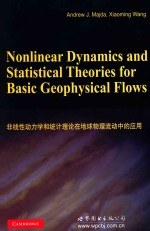图书介绍
非线性动力学和统计理论在地球物理流动中的应用 英文版pdf电子书版本下载

- (美)马伊达,王晓宁著 著
- 出版社: 北京:世界图书北京出版公司
- ISBN:9787510086281
- 出版时间:2015
- 标注页数:551页
- 文件大小:92MB
- 文件页数:563页
- 主题词:非线性力学-动力学系统-应用-地球物理学-流体力学-英文;统计学-应用-地球物理学-流体力学-英文
PDF下载
下载说明
非线性动力学和统计理论在地球物理流动中的应用 英文版PDF格式电子书版下载
下载的文件为RAR压缩包。需要使用解压软件进行解压得到PDF格式图书。建议使用BT下载工具Free Download Manager进行下载,简称FDM(免费,没有广告,支持多平台)。本站资源全部打包为BT种子。所以需要使用专业的BT下载软件进行下载。如 BitComet qBittorrent uTorrent等BT下载工具。迅雷目前由于本站不是热门资源。不推荐使用!后期资源热门了。安装了迅雷也可以迅雷进行下载!
(文件页数 要大于 标注页数,上中下等多册电子书除外)
注意:本站所有压缩包均有解压码: 点击下载压缩包解压工具
图书目录
1 Barotropic geophysical flows and two-dimensional fluid flows:elementary introduction 1
1.1 Introduction 1
1.2 Some special exact solutions 8
1.3 Conserved quantities 33
1.4 Barotropic geophysical flows in a channel domain-an important physical model 44
1.5 Variational derivatives and an optimization principle for elementary geophysical solutions 50
1.6 More equations for geophysical flows 52
References 58
2 The response to large-scale forcing 59
2.1 Introduction 59
2.2 Non-linear stability with Kolmogorov forcing 62
2.3 Stability of flows with generalized Kolmogorov forcing 76
References 79
3 The selective decay principle for basic geophysical flows 80
3.1 Introduction 80
3.2 Selective decay states and their invariance 82
3.3 Mathematical formulation of the selective decay principle 84
3.4 Energy-enstrophy decay 86
3.5 Bounds on the Dirichlet quotient,∧(t) 88
3.6 Rigorous theory for selective decay 90
3.7 Numerical experiments demonstrating facets of selective decay 95
References 102
A.1 Stronger controls on ∧(t) 103
A.2 The proof of the mathematical form of the selective decay principle in the presence of the beta-plane effect 107
4 Non-linear stability of steady geophysical flows 115
4.1 Introduction 115
4.2 Stability of simple steady states 116
4.3 Stability for more general steady states 124
4.4 Non-1inear stability of zonal flows on the beta-plane 129
4.5 Variational characterization of the steady states 133
References 137
5 Topographic mean flow interaction,non-linear instability,and chaotic dynamics 138
5.1 Introduction 138
5.2 Systems with layered topography 141
5.3 Integrable behavior 145
5.4 A limit regime with chaotic solutions 154
5.5 Numerical experiments 167
References 178
Appendix 1 180
Appendix 2 181
6 Introduction to information theory and empirical statistical theory 183
6.1 Introduction 183
6.2 Information theory and Shannon's entropy 184
6.3 Most probable states with prior distribution 190
6.4 Entropy for continuous measures on the line 194
6.5 Maximum entropy principle for continuous fields 201
6.6 An application of the maximum entropy principle to geophysical flows with topography 204
6.7 Application of the maximum entropy principle to geophysical flows with topography and mean flow 211
References 218
7 Equilibrium statistical mechanics for systems of ordinary differential equations 219
7.1 Introduction 219
7.2 Introduction to statistical mechanics for ODEs 221
7.3 Statistical mechanics for the truncated Burgers-Hopf equations 229
7.4 The Lorenz 96 model 239
References 255
8 Statistical mechanics for the truncated quasi-geostrophic equations 256
8.1 Introduction 256
8.2 The finite-dimensional truncated quasi-geostrophic equations 258
8.3 The statistical predictions for the truncated systems 262
8.4 Numerical evidence supporting the statistical prediction 264
8.5 The pseudo-energy and equilibrium statistical mechanics for fluctuations about the mean 267
8.6 The continuum limit 270
8.7 The role of statistically relevant and irrelevant conserved quantities 285
References 285
Appendix 1 286
9 Empirical statistical theories for most probable states 289
9.1 Introduction 289
9.2 Empirical statistical theories with a few constraints 291
9.3 The mean field statistical theory for point vortices 299
9.4 Empirical statistical theories with infinitely many constraints 309
9.5 Non-1inear stability for the most probable mean fields 313
References 316
10 Assessing the potential applicability of equilibrium statistical theories for geophysical flows:an overview 317
10.1 Introduction 317
10.2 Basic issues regarding equilibrium statistical theories for geophysical flows 318
10.3 The central role of equilibrium statistical theories with a judicious prior distribution and a few external constraints 320
10.4 The role of forcing and dissipation 322
10.5 Is there a complete statistical mechanics theory for ESTMC and ESTP? 324
References 326
11 Predictions and comparison of equilibrium statistical theories 328
11.1 Introduction 328
11.2 Predictions of the statistical theory with a iudicious prior and a few external constraints for beta-plane channel flow 330
11.3 Statistical sharpness of statistical theories with few constraints 346
11.4 The limit of many-constraint theory(ESTMC)with small amplitude potential vorticity 355
References 360
12 Equilibrium statistical theories and dynamical modeling of flows with forcing and dissipation 361
12.1 Introduction 361
12.2 Meta-stability of equilibrium statistical structures with dissipation and small-scale forcing 362
12.3 Crude closure for two-dimensional flows 385
12.4 Remarks on the mathematical iustifications of crude closure 405
References 410
13 Predicting the jets and spots on Jupiter by equilibrium statistical mechanics 411
13.1 Introduction 411
13.2 The quasi-geostrophic model for interpreting observations and predictions for the weather layer of Jupiter 417
13.3 The ESTP with physically motivated prior distribution 419
13.4 Equilibrium statistical predictions for the jets and spots on Jupiter 423
References 426
14 The statistical relevance of additional conserved quantities for truncated geophysical flows 427
14.1 Introduction 427
14.2 A numerical 1aboratory for the role of higher-order invariants 430
14.3 Comparison with equilibrium statistical predictions with a iudicious prior 438
14.4 Statistically relevant conserved quantities for the truncated Burgers-Hopf equation 440
References 442
A.1 Spectral truncations of quasi-geostrophic flow with additional conserved quantities 442
15 A mathematical framework for quantifying predictability utilizing relative entropy 452
15.1 Ensemble prediction and relative entropy as a measure of predictability 452
15.2 Quantifying predictability for a Gaussian prior distribution 459
15.3 Non-Gaussian ensemble predictions in the Lorenz 96 model 466
15.4 Information content beyond the climatology in ensemble predictions for the truncated Burgers-Hopf model 472
15.5 Further developments in ensemble predictions and information theory 478
References 480
16 Barotropic quasi-geostrophic equations on the sphere 482
16.1 Introduction 482
16.2 Exact solutions,conserved quantities,and non-linear stability 490
16.3 The response to large-scale forcing 510
16.4 Selective decay on the sphere 516
16.5 Energy enstrophy statistical theory on the unit sphere 524
16.6 Statistical theories with a few constraints and statistical theories with many constraints on the unit sphere 536
References 542
Appendix 1 542
Appendix 2 546
Index 550